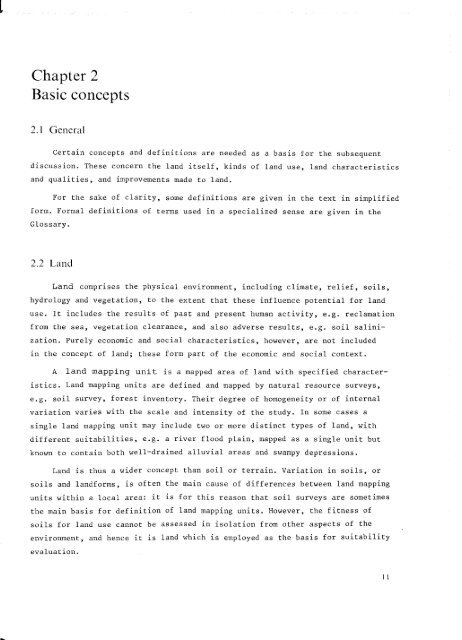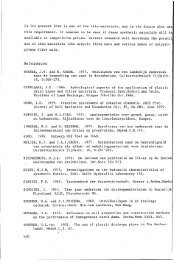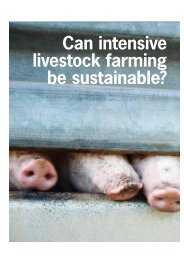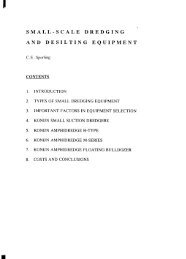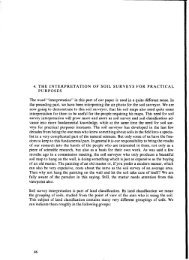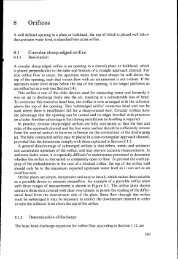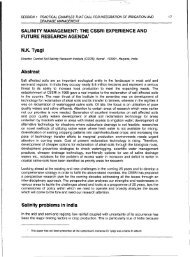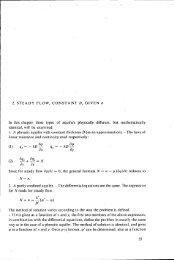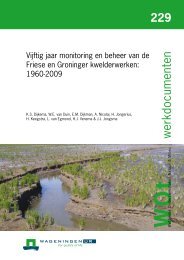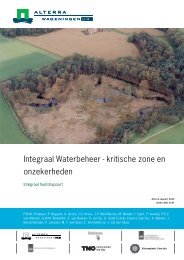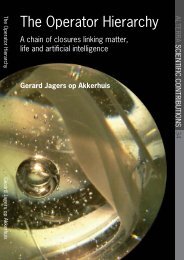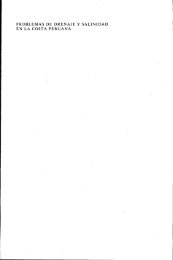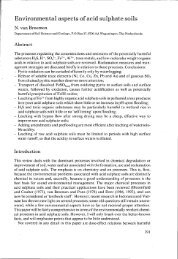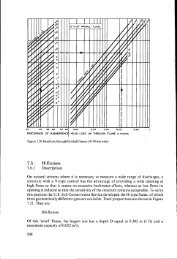Chapter 2 Basic concepts - ROOT of content
Chapter 2 Basic concepts - ROOT of content
Chapter 2 Basic concepts - ROOT of content
You also want an ePaper? Increase the reach of your titles
YUMPU automatically turns print PDFs into web optimized ePapers that Google loves.
- Technology employed (e.g. implements and machinery, fertilizers,livestock breeds, farm transport, methods <strong>of</strong> timber felling)- Infrastructure requirements (e.g. sawmills, tea factories,agricultural advisory services)- Size and configuration <strong>of</strong> land holdings, including whetherconsolidated or fragmented- Land tenure, the legal or customary manner in which rightsto land are held, by individuals or groups- Income levels, expressed per capita, per unit <strong>of</strong> production(e.g. farm) or per unit area.Management practices on different areas within one land utilization typeare not necessarily the same. For example, the land utilization type may consist<strong>of</strong> mixed farming, with part <strong>of</strong> the land under arable use and part allocated tograzing. Such differences may arise from variation in the land, from the requirements<strong>of</strong> the management system, or both.Some examples <strong>of</strong> land utilization types are:i.ii.iii.iv .V.vi.Rainfed annual cropping based on groundnuts with subsistence maize,by smallholders with low capital resources, using cattle-drawn farmimplements, with high labour intensity, on freehold farms <strong>of</strong> 5-10 ha.Farming similar to (i) in respect <strong>of</strong> production, capital, labour, powerand technology, but farms <strong>of</strong> 200-500 ha operated on a communal basis.Commercial wheat production on large freehold farms, with high capitaland low labour intensity, and a high level <strong>of</strong> mechanization and inputs.Extensive cattle ranching, with medium levels <strong>of</strong> capital and labourintensity, with land held and central services operated by a governmentalagency.S<strong>of</strong>twood plantations operated by a government Department <strong>of</strong> Forestry,with high capital intensity, low labour intensity, and advancedtechnology.A national park for recreation and tourism.Some descriptions <strong>of</strong> land utilization types are given in <strong>Chapter</strong> 5.IWhere it is wished to relate agricultural land utilization types to ageneral classification, the Typology <strong>of</strong> World Agriculture <strong>of</strong> the InternationalGeographical Union may be considered (Kostrowicki, 1974). The role <strong>of</strong> landutilization types in land evaluation is discussed further in Beek (1975).13
42.3.2 Multiple and compound land useTwo terms,multiple and compound land utilization types,refer to situationsin which more than one kind <strong>of</strong> land use is practised within an area.A multiple land utilization type consists <strong>of</strong> more than one kind <strong>of</strong>use simultaneously undertaken on the same area <strong>of</strong> land, each use having its owninputs, requirements and produce. An example is a timber plantation used simultaneouslyas a recreational area.A compound land utilization type consists <strong>of</strong> more than one kind <strong>of</strong>use undertaken on areas <strong>of</strong> land which for purposes <strong>of</strong> evaluation are treated asa single unit. The different kinds <strong>of</strong> use may occur in time sequence (e.g.asin crop rotation) or simultaneously on different areas <strong>of</strong> land within the sameorganizational unit. Mixed farming involving both arable use and grazing is anexample.Sometimes an appropriate land utilization type can be found by making severalland mapping units part <strong>of</strong> the same management unit, e.g. livestock managementwhich combines grazing on uplands in the rainy season and on seasonally floodedlowlands in the dry season.Land utilization types are defined for the purpose <strong>of</strong> land evaluation.Their description need not comprise the full range <strong>of</strong> farm management practices,but only those related to land management and improvement. At detailed levels<strong>of</strong> evaluation, closely-defined land utilization types can be extended int<strong>of</strong>arming systems by adding other aspects <strong>of</strong> farm management. Conversely, farmingsystems that have already been studied and described can be adopted as thebasis for land utilization types.2.4 Land characteristics, land qualities and diagnosticcriteriaA land characteristic is an attribute <strong>of</strong> land that can be measuredor estimated. Examples are slope angle, rainfall, soil texture, available watercapacity, biomass <strong>of</strong> the vegetation, etc. Land mapping units, as determinedby resource surveys, are normally described in terms <strong>of</strong> land characteristics.If land characteristics are employed directly in evaluation, problems arisefrom the interaction between characteristics. For example, the hazard <strong>of</strong> soilerosion is determined not by slope angle alone but by the interaction between14
cslope angle, slope length, permeability, soil structure, rainfall intensity andother characteristics. Because <strong>of</strong> this problem <strong>of</strong> interaction,it is recommendedthat the comparison <strong>of</strong> land with land use should be carried out. in terms <strong>of</strong> landqualities.A land quality is a complex attribute <strong>of</strong> land which acts in a distinctmanner in its influence on the suitability <strong>of</strong> land for a specific kind <strong>of</strong> use.Land qualities may be expressed in a positive or negative way. Examples aremoisture availability, erosion resistance, flooding hazard, nutritive value <strong>of</strong>pastures, accessibility. Where data are available, aggregate land qualities mayalso be employed, e.g. crop yields, mean annual increments <strong>of</strong> timber species.Table 1 gives an illustrative list <strong>of</strong> land qualities related to productivityfrom three kinds <strong>of</strong> use and to management and inputs.It is not exhaustive, nor iseach land quality necessarily relevant for a particular area and type <strong>of</strong> land use.The qualities listed in B and C are in addition to those <strong>of</strong> A, which may be relevantto all three kinds <strong>of</strong> use (based in part on Beek and Bennema, 1972). Theremay also be land qualities related to major land improvements. These vary widelywith the types <strong>of</strong> improvement under consideration. An example is land evaluationin relation to available supplies <strong>of</strong> water where irrigation is being considered.A land quality is not necessarily restricted in its influence to one kind <strong>of</strong>use. The same quality may affect, for example, both arable use and animal production.There are a very large number <strong>of</strong> land qualities, but only those relevantto the land use alternatives under consideration need be determined. A landquality is relevant to a given type <strong>of</strong> land use if it influences either the level<strong>of</strong> inputs required, or the magnitude <strong>of</strong> benefits obtained, or both. For example,capacity to retain fertilizers is a land quality relevant to most forms <strong>of</strong>agriculture, and one which influences both fertilizer inputs and crop yield.Erosion resistance affects the costs <strong>of</strong> soil conservation works required forarable use, whilst the nutritive value <strong>of</strong> pastures affects the productivity <strong>of</strong>land under ranching.Land qualities can sometimes be estimated or measured directly, but arefrequently described by means <strong>of</strong> land characteristics. Qualities or characteristicsemployed to determine limits <strong>of</strong> land suitability classes or subclassesare known as diagnostic criteria.15
A diagnostic criterion is a variable which has an understood influenceupon the output from, or the required inputs to, a specified use, andwhich serves as a basis for assessing the suitability <strong>of</strong> a given area <strong>of</strong> landfor that use. This variable may be a land quality, a land characteristic, or afunction <strong>of</strong> several land characteristics. For every diagnostic criterion therewill be a critical value or set <strong>of</strong> ciitical values which are used to definesuitability class limits.TABLE 1.EXAMPLES OF LAND QUALITIESA. LAND QUALITIES RELATEU 'TO PKOUUCTIVITY FKOM CROPS OK OTHER PLANT GROiJTH- Crop yields (a resultant <strong>of</strong> many qualities listed below)- Moisture availability- Nutrient availability- Oxygen availability in the root zone- Adequacy <strong>of</strong> foothold for roots- Conditions far germination- Workability <strong>of</strong> the land (ease <strong>of</strong> cultivalion)- Salinity or alkalinity- Soil toxicity- Resistance to soil erosion- Pests and diseases related to the land- Flooding hazard (including frequency, periods af inundation)- Temperature regime- Radiation energy and photoperiod- Climatic hazards affecting plant growth (including wind, hail, frost)- Air humidity as affecting plant growth- Drying periods ïor ripening <strong>of</strong> crops8. LAND QUALITIES KELATEU TO DOMESTIC ANIMAL PKODUCTIVITY- Productivity <strong>of</strong> grazing land (a resultant <strong>of</strong> many qualities listed under A)- Climatic hardships affecting animals- Endemic pests and diseases- Nutritive value <strong>of</strong> grazing land- Toxicity <strong>of</strong> grazing land- Kesistance to degradation <strong>of</strong> vegecation- Resistance to soil erosion under grazing conditions- Availability <strong>of</strong> drinking waterC. LAND QUALlTlES RELATED TO FOKEST PRODUCTIVITY'The qualities listed may refer to natural forests, forestry plantations,or both.- Mean annual increments <strong>of</strong> timber species (a resultant <strong>of</strong> many qualitieslisted under A)- Types and quantities <strong>of</strong> indigenous timber species- site factors affecting establishment <strong>of</strong> young trees- Pests and diseases- Fire hazardD. LAND QUALITIES RELATED TO MANAGEMENT AND INPUTSThe qualities listed may refer to arable use, animal production or iorestry.Terrain factors affecting mechanization (trafficability)- Terrain factors affecting construction and maintenance <strong>of</strong> access ruads(accessibility)- Size <strong>of</strong> potential management units (e.g. forest blocks, ïarms, fields)- Location in relation to markets and to supplies <strong>of</strong> inputs16
E2.4.1 ExamplesThese terms may be illustrated with reference to the land quality "oxygenavailability in the root zone". This quality can be most closely estimated bythe diagnostic criterion <strong>of</strong> the period when the redox potential (Eh) in the rootzone is less than +ZOO millivolts. Such information would frequently not beavailable, in which case the next most direct criterion would be periods whenthe root zone lay below the water table. For example, oxygen availability mightbe classed as "moderate" with 3-6 months below the water table, and "low" withover 6 months. Failing information on periods with a high water table, then soilmottling, soil drainage class or natural vegetation could be used as diagnosticcriteria for assessing oxygen availability.Land qualities can sometimes be described by means <strong>of</strong> a single land characteristic,as in the preceding example. In many cases, however, their ratinginvolves combinations <strong>of</strong> several characteristics, as in the case <strong>of</strong> moistureavailability illustrated by the following example.Moisture availability to plants is a land quality that is relevant in awide variety <strong>of</strong> circumstances. It can apply to arable cropping, animal productivity(via its influence on growth <strong>of</strong> pastures) and forest production. It canaffect both productivity, e.g. crop yields, and inputs, e.g. mulching measuresnecessary,or amounts <strong>of</strong> irrigation water required. Among the land characteristicswhich affect the quality moisture availability are: amount <strong>of</strong> rainfall, itsseasonal distribution and variability; potential evapotranspiration, and hencethe characteristics which themselves affect it (temperature, humidity, windspeed, etc.); and available water capacity <strong>of</strong> the soil, and the characteristicswhich affect it - effective soil depth (depth to which roots penetrate) and thefield capacity and wilting point <strong>of</strong> each soil horizon, the latter being in turninfluenced by texture, organic matter <strong>content</strong>, etc. The probable recurrenceinterval at which the soil moisture level falls to wilting point within theentire rooting zone is a further land characteristic <strong>of</strong> importance (which can beestimated but not measured within a short period). By no means all these landcharacteristics would be employed as diagnostic criteria. Supposing, for example,that differences in both rainfall and potential evapotranspiration within thesurveyed area were so small as to be <strong>of</strong> little importance in differentiatingtypes <strong>of</strong> land, then this characteristic would become part <strong>of</strong> the physical context<strong>of</strong> the evaluation and would not be used in defining class limits. The mostappropriate diagnostic criterion used to define class limits might be available
water capacity <strong>of</strong> the soil pr<strong>of</strong>ile. However,where such data were not available,some function <strong>of</strong> effective depth and soil texture, believed to bear a linearrelationship with available water capacity, could be used. In the former case,the set <strong>of</strong> critical values for available water capacity used to define classlimits might be such as: over 20 cm, 15-20 cm, 12-15 cm.2.4.2 The scarcity value <strong>of</strong> landThe value <strong>of</strong> a particular type <strong>of</strong> land may be increased by its scarcity,or the rarity <strong>of</strong> certain <strong>of</strong> its qualities, within a given region or country. Thisis <strong>of</strong>ten the position with nature reserves. In the extreme case, the presence <strong>of</strong>a plant or animal species unique to one area may make that land virtually irreplaceable,resulting in strict protection even against highly pr<strong>of</strong>itable otheruses. Situations where land acquires added suitability for a particular use byvirtue <strong>of</strong> its scarcity can also arise with productive forms <strong>of</strong> use, for examplewhere dry-season grazing land is in short supply.2.5 Requirements and limitationsRequirements <strong>of</strong> the land use refer to the set <strong>of</strong> land qualities thatdetermine the production and management conditions <strong>of</strong> a kind <strong>of</strong> land use.Limitations are land qualities, or their expression by means <strong>of</strong> diagnosticcriteria, which adversely affect a kind <strong>of</strong> land use.For example, the requirements for mechanized cultivation <strong>of</strong> wheat includehigh availability <strong>of</strong> oxygen in the root zone and absence <strong>of</strong> obstructions (bouldersor rock outcrops); waterlogging and the presence <strong>of</strong> boulders are limitations.Thus limitations may be regarded as land qualities expressed in such a way asto show the extent to which the conditions <strong>of</strong> the land fall short <strong>of</strong> the requirementsfor a given use.18
2.6 Land improvementsLand improvements are activities which cause beneficial changes in thequalities <strong>of</strong> the land itself. Land improvements should be distinguished fromimprovements in land use, i.e. changes in the use to which the land is put ormodifications to management practices under a given use.Land improvements are classed as major or minor.A major land improvement is a substantial and reasonably permanentimprovement in the qualities <strong>of</strong> the land affecting a given use. A large nonrecurrentinput is required, usually taking the form <strong>of</strong> capital expenditure onstructure and equipment. Once accomplished, maintenance <strong>of</strong> the improvementremains as a continuing cost, but the land itself is more suitable for the usethan formerly. Examples are large irrigation schemes, drainage <strong>of</strong> swamps andreclamation <strong>of</strong> salinized land.A minor land improvement is one which either has relatively smalleffects or is non-permanent or both, or which lies within the capacity <strong>of</strong> individualfarmers or other land users. Stone clearance, eradication <strong>of</strong> persistentweeds and field drainage by ditches are examples.The separation <strong>of</strong> major from minor land improvements is intended onlyas an aid to making a suitability classification. The distinction is a relativeone; it is not clear-cut and is only valid within a local context. In cases <strong>of</strong>doubt, the main criterion is whether the improvement is within the technical andfinancial capacity <strong>of</strong> individual farmers or other landowners (including smallcommunal owners, e.g. village co-operatives). In many areas improvements suchas subsoiling, dynamiting or terracing cannot be undertaken by individualfarmers, and are therefore regarded as major land improvements; in countrieswith large farms and high capital resources coupled with good credit facilities,however, these changes may be within reach <strong>of</strong> individuals and are thereforeconsidered as minor improvements. Field drainage is another improvement thatmay or may not be regarded as major, depending on farm size,permanency <strong>of</strong> tenure,capital availability and level <strong>of</strong> technology.19
2.7 Land suitability and land capabilityThe term "land capability" is used in a number <strong>of</strong> land classificationsystems, notably that <strong>of</strong> the Soil Conservation Service <strong>of</strong> the U.S.Department<strong>of</strong> Agriculture (Klingebiel and Montgomery, 1961). In the USDA system, soil mappingunits are grouped primarily on the basis <strong>of</strong> their capability to producecommon cultivated crops and pasture plants without deterioration over a longperiod <strong>of</strong> time. Capability is viewed by some as the inherent capacity <strong>of</strong> landto perform at a given level for a general use, and suitability as a statement<strong>of</strong> the adaptability <strong>of</strong> a given area for a specific kind <strong>of</strong> land use; others seecapability as a classification <strong>of</strong> land primarily in relation to degradationhazards, whilst some regard the terms "suitability" and "capability" as interchangeable.Because <strong>of</strong> these varying interpretations, coupled with the long-standingassociation <strong>of</strong> "capability" with the USDA system, the term land suitability isused in this Framework, and no further reference to capability is made.20


